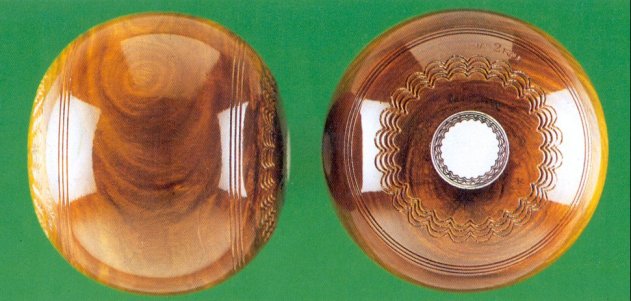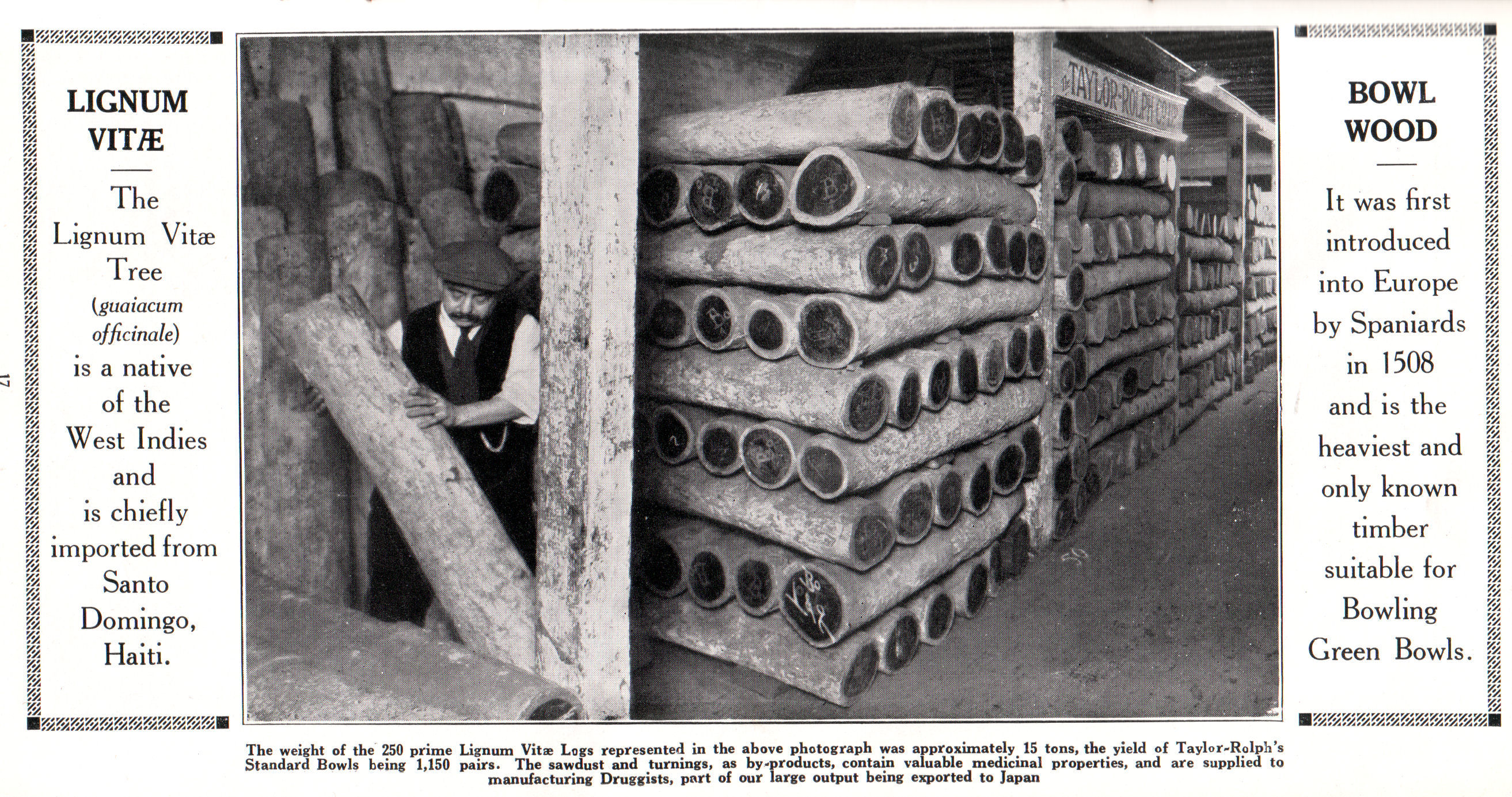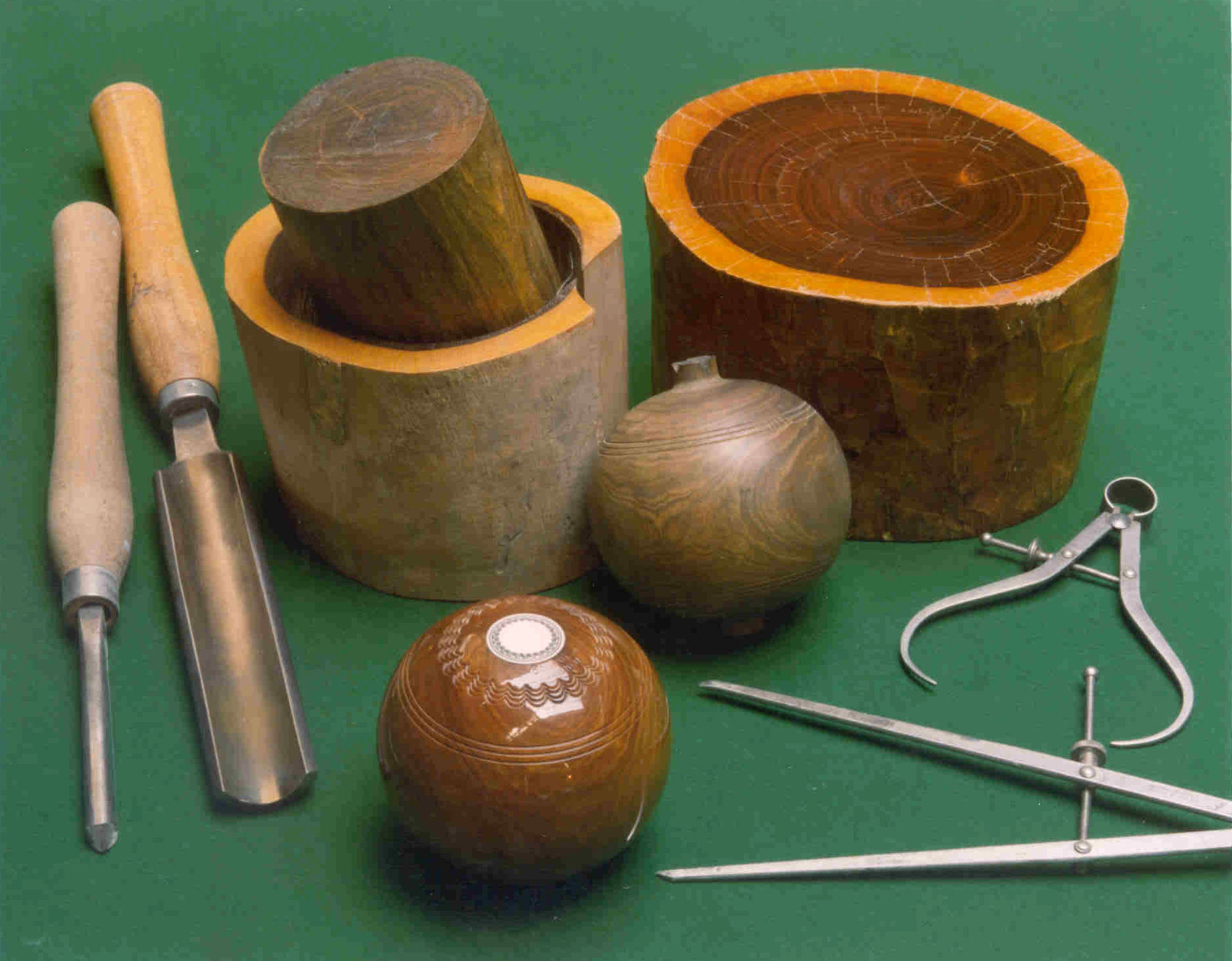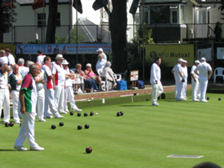Article 4 - Lignum Bowls
ARTICLE 4 - Lignum Bowls
(Originally published in 1996 and revised in 2009)
In this forth article, I thought a mention of the traditional
manufacturing methods might be of interest. Drakes Pride is
probably the last of the bowls manufacturers to still make "brand
new" Lignum Vitae bowls. These are made mainly for the crown green
bowls players (See photograph)., but occasionally also for a lawn
bowler, however at over £300 per set of four (1997 price), perhaps
they are only used as presentation sets.(Since 2002, based on World
Bowls Ltd. regulations we could not put the official stamp on
Lignum Vitae Bowls)

The colour and grain of high grade
Lignum Vitae Bowls, polished are a delight to see and as timber has
a warm 'feel' they are also very tactile.

Picture from Taylor-Rolphs 1935
catalogue showing their stock of Lignum Vitae logs
Lignum Vitae is a timber now on the
United Nation CITES list, thus requires special licences for the
export and import of same, and so it is even more difficult to
obtain suitable timber for the manufacture of bowls.
Lignum Vitae is one of the most
outstanding of all timbers, it is not only one of the hardest and
heaviest known, but has an almost unique property of being
self-lubricating. As a result, not only was it used for lawn bowls
but also for bearings and bushing blocks for propeller shafts of
ships, as well as being ideal for pulleys on sailing ships. Those
who had high quality clothes mangles, to put your washing through,
would also perhaps have recognised that the bottom roller was also
made from Lignum Vitae. The Taylor-Rolph picture of logs mentions
its medicinal properties and they exported the turnings and saw
dust to Japan. The writer can also remember that the Lignum sawdust
was sold to a London pharmaceutical firm.
The tradition of making bowls in Liverpool goes back a long way.
It was in 1820 that Darlington's was founded and therefore as
Drakes Pride was formed from the nucleus of that firm, it can trace
its methods and knowledge back to that date. Of course Thomas
Taylor's of Glasgow, are older, they are celebrating their
bicentennial this year(1996), having been founded in 1796, but they
no longer produce Lignum Vitae bowls.
The way Lignum Vitae bowls were made was a very skilled job, not
just from the skills needed for hand turning, but right from the
initial selection of the original logs. The careful cutting to
ensure that a set of four came not only from the same log but from
along side each other in that log. In the 1970's it was already
getting difficult to obtain Lignum in log form as the exporting
countries wanted to retain some additional value in their country.
So Drakes Pride imported turned cylinders of lignum, the centre of
the cylinder being as close to the heart of the log as possible.
The cylinders were dipped in wax to seal them to prevent cracking
during shipping. The wax basically did the job of protecting the
cylinder of timber in the same way the sap wood would have done
when it was shipped in log form.
There are three species of Lignum Vitae and only one of which is
really suitable, that is "Guiacum Officinale", so knowledge of the
species is required. Interestingly, Lignum is bought by weight,
rather than the more usual, for logs, cubic measurement. Once the
logs were accepted as the correct species, the next stage in the
selection can proceed.
Those logs which had too large a heart crack, would be
unsuitable, note however that all Lignum Vitae has a heart crack,
and it is likely that the white mounts (discs as seen in the
photograph of a pair of bowls at the start of this article) were
used originally to hide these cracks. The heart of the timber has
to be so positioned, in the log to allow it to be the centre of the
bowl. So if it was too close to one side to allow for this, the log
would be rejected. The heart timber, itself, is very dark in
colour, but the sap wood is pale yellow in colour and is sharply
defined. It is only the dark timber that is required, so any logs
that did not have sufficient diameter of dark timber would be
rejected, and equally if the log was too large in diameter,
resulting in too much waste this would also be rejected. After the
initial careful inspection and selection, the timber passing the
selection could be purchased.

The next stage is to produce the "blanks" from which the
craftsman turner, would make the bowls. For any Lignum bowls, to
make a set the "blanks" they have to come, not only from the same
log but also side by side in that log. Otherwise, the specific
gravity of the bowls would not be the same, given that they are
from a naturally grown piece of timber, and the likelihood of the
bowls being of "similar" weights, could not be expected or
achieved.
The first stage of producing the "blank" from the selected log,
was basically to produce a cylinder which could be put between the
centres of a ball turning lathe. It in worth noting that at every
stage, the timber requires careful inspection and sealing, to
ensure that it does not crack.
The craftsman turner, would take the rough ball shaped blank,
and turn it into the recognisable shape of a bowl. The skill
required to do this, using only hand tools and a template, to give
the running sole shape, was to say the least an art, and was down
to eye and hand co-ordination as well as experience. By offering up
the sole template to the piece being turned, and judging the
amounts of material to be turned off, the craftsman would produce
the required shape and dimensions, they would also position the top
rings which delineated the running sole.
After that first stage the mounts (discs) would be fitted and
the inner rings and any other decoration would be cut onto the
bowl. Then followed the next, most skilful job, checking out the
bias. As you can imagine, even allowing for the skill of the
turner, the bowls required biasing to that specified by the
customer and or the governing bodies of the game. The examination
of the bias was, and still is, done on the test table, which is, as
mentioned in an earlier article, used as a quality control device
rather than the means of knowing what the bowl would do on the
green.
It is amazing, just how little material needs to be sanded off
to adjust the bias of the bowl either to make the bias stronger or
weaker. The skill is knowing how to remove as little as possible,
whilst still being able to retain the basic geometric "proven
template" shape. If the "proven template" shape in altered then the
bowls may be able to be made to run down the test table acceptably
but might not do so on the green - thus great skill and knowledge
is required.
Finally, the bowl would have been hand polished either black if
the original timber was not considered to be 100% or natural, using
a clear finish, if the timber was considered the very best. I am
sure there are still a lot of crown green bowlers who have found
memories of the "Extra Quality" bowls, which were polished natural
and had the Deluxe decoration on them. I know that if any bowler
has lost their bowls, they always seem to describe them as being of
that quality! Now we use a very hard wearing spray finish rather
than hand polishing with shellac.
These traditional skills still exist. Although now the "ball"
shape blank is turned on the same C.N.C. lathes as we use for our
Drakes Pride composition bowls, which means that they are more
accurately made to the required geometric shape, than could have
been achieved, by even the most skilled craftsman. All the other
skills remain the same, especially, when it comes to the biasing.
The new Lignum Vitae bowls will lose some 20gms - 46gms in weight
in the first year, after that, with care and attention, involving
bowls being re-polished at least biannually they should give many,
many years of service.
One of the reasons that Composition bowls were first introduced,
was that in hot weather, as experienced in the Southern Hemisphere,
Lignum Vitae bowls were prone to split, the Dunlop company being
one of the first companies to introduce a replacement material
using a rubber compound.
So, in Australia and New Zealand, bowlers will probably
only know Lignum Vitae bowls from their display cabinets, whereas
Drakes Pride based in the North of England means we see many
thousands of Crown Green Lignum Vitae bowls each year as they pass
through our factory for renovation and re-polishing.
So, "woods" are still going strong, but the composition bowls
are taking a larger and larger market share. In the next article, I
will cover the processes of the manufacture of Composition
bowls.
Some Information on Lignum Vitae the 'wood' used for bowls
LIGNUM VITAE
(Guiacum officinale L.
principally; also G. sanctum L. &
G. guatamalense Planch. Family - Zygophyllaceae.)
Other Names.
Guiacum wood. Bois de Gaiac (Fr.), Porkholz (Ger), Pokhout
(Dutch), Lignum Sanctum (P.R.).
General Description.
Lignum Vitae is one of the most outstanding of all timbers, as
it is not only one of the hardest and heaviest known woods, but
also has the almost unique property of being self-lubricating -
that is, of containing sufficient oil or resin to make it suitable
for bearings, etc., without either catching fire from friction, or
needing any oil.
The sapwood of G. officinale is narrow, pale yellow in colour
and sharply defined. Logs which have lain for a long time in the
forest may lack the sapwood altogether. In Bahama Lignum (G.
sanctum) the sapwood is very wide, sometimes 9 in. in a 10in. log.
Heartwood varies from olive green to brown or almost black, often
somewhat streaked; on exposure the colour darkens. Figure is
occasionally fond, due either to changes in colour or a fine
ripple, caused by the very interlocked grain. The wood is slightly
scented, but this is only noticeable when the wood is warmed or
rubbed. The texture is fine and uniform, and the wood has a
characteristically oiled feel. Its weight varies from 72 to 83lb. A
cu. Ft. (when seasoned to 15 per cent. moisture content), averaging
about 78lb.
Seasoning.
A somewhat refractory wood to season, needing considerable care
to avoid streaks.
Strength.
Extremely resistant to abrasive wear although somewhat brittle
under impact, very difficult to split radially, but comparatively
easy on a tangential plane. Extremely hard: the Forest Products
Research Laboratory state that it is three to four times as hard as
English oak.
Durability.
Extremely resistant to decay and insect attack: damage has,
however, occasionally been caused to logs by longhorn beetles. The
wood is acid resisting.
Working Qualities.
It is difficult to work with hand tools and hard to saw and
machine, tending to ride over cutters in planning and increased
loading to pressure bars is necessary. The cutting angle should not
exceed 15 degrees. It turns excellently and takes a high
polish.
Uses.
Its principal uses are for bearings and bushing blocks, for
propeller shaft of ships (where it is reported to last from three
to seven years). No wood has proved satisfactory as a substitute.
It is ideal for pulley sheaves (where it has been reported to last
for 50 years in good condition), dead eyes, caster wheels, etc.
It is also used for
"woods" in the game of bowls, and for turnery; bowls, etc.,
of this wood have been made since the early 17th century. It is
stated that it is replacing metal for bearings in roller mills, in
steel and tube works, as it is cheaper and has a longer life than
metal, and needs no lubrication.
It has been used for sleepers in Panama, but these were taken up
after 30 years (because too small for a new track) and used again
for dock work.
Notes concerning its use for Bowling Green Bowls based on Drakes
Pride experience:
1) The best Lignum for bowls was said to be from Santo Domingo
and should be from Guiacum Officinale.
2) Drakes Pride expect 'new' timber to have a specific gravity
of about 1.36 sg. Which would fall to about 1.32 after 1st season
playing bowls.
3) Even in the UK Bowls made from the timber will crack and
become useless if left in direct sunlight or if they become too
hot. So it proved to be basically unsuitable in hotter climates
such as Australia and South Africa.
4) Lignum bowls are still used quite extensively for Crown Green
Bowls.
© Peter Clare 2009 - © E.A. Clare & Son Ltd 2018. This
article can only be reproduced in part or whole with the permission
of E.A. Clare & Son Ltd.

